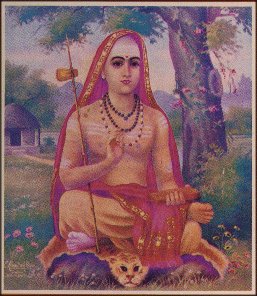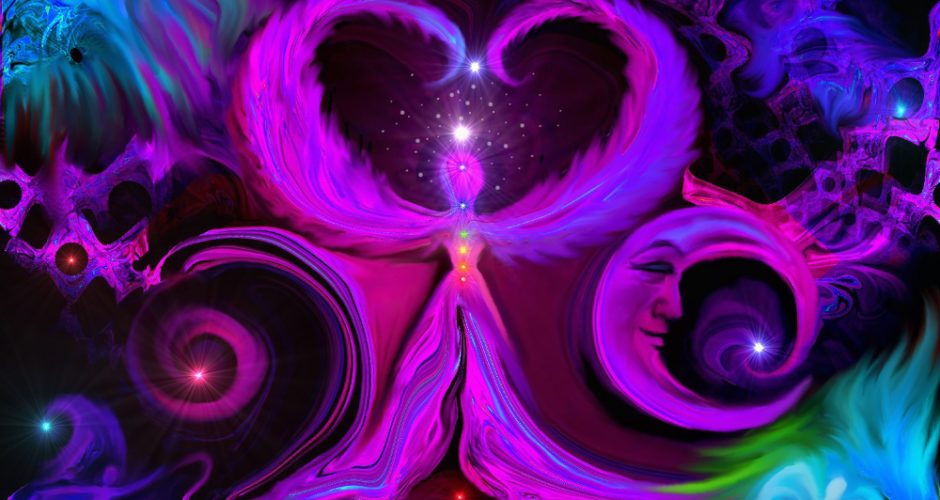Introduction
Based on a number of requests to explain the basics of Eastern philosophies in English for those daunted by the sheer volume of foreign terms, I have attempted to present a simplified summary of basic concepts in one document. I’m only a student myself, so I assume all responsibility for any inaccuracies in the following information.
Advaita (Non-Dualism) – We are not separate, but continuous with everything

Adi Shankara
In Sanskrit, which is the root language for the Indo-European language family, the word Advaita (a = non, dvaita=dualism – compare to asexual, atypical) describes a philosophy that Reality, whatever it may be, is not fundamentally two things. This is comparable to Baruch Spinoza’s 17th century philosophy that whatever is, is one, and we could call that Reality, or Nature, or God (if it suits you).
This is the opposite of the assertion of the Abrahamic Tradition (i.e. Judaism, Christianity, Islam) which propose a strong Dualism (Sanskrit Dvaita), or the belief that Reality boils down to two things: Creator and Creation.
Hinduism also has some Dvaita or Dvaita-influenced sects, most noticeably the Gaudiya Vaishnava or Hare Krishna movement, whose actual philosophy is bhedabheda, or “oneness and difference” – though, for all practical purposes, it functions as Dualism (comparable to Christianity but with the concepts of karma and reincarnation).
Atman=Brahman – We are the whole Universe
In Sanskrit, the word Atman means the Self – your true identity, the thing that you really are, an eternal consciousness that is not the form you currently occupy limited by time and space, by body, language, culture etc.
This “Real You” is said to be identical with the Brahman. Brahman comes from a root meaning to grow or expand, and can be thought of as Ultimate Reality, or the Totality of Being, or everything that has existence. So, the assertion here is that what you really are is non-different from the totality of what is.

Alan Watts
The Buddhist philosopher Alan Watts used the example of an ink blot – if you throw some ink at a wall, the ink will spread out from a central point and eventually form all these intricate little curly cues on the periphery.
He said that we humans think of the Big Bang as some event long ago and ourselves as somehow separate from the rest of the Universe; we see ourselves as that one, tiny, insignificant curly cue out on the fringes of everything, but we are the leading edge of the Big Bang as it expands in the dimension of Time, and awakening is that moment when the wave realizes it is the ocean.
This concept is also sometimes summarized as tat tvam asi (“that thou art”), or the notion that everything you see “out there” is non-different from that which you really are. The Persian poet Rumi, whose mysticism bordered on Advaita philosophy at times, said that the whole Universe is just a language to express the infinite within.
Purna – We are infinite
 Purna is a Sanskrit word that provides the roots for more familiar Indo-European words including complete, plenary, pure, and full. It indicates a fullness, a complete totality of Being, an infinity. It is in this mathematical sense of the infinite that it the following verse, the Purna Stotram, is most often translated:
Purna is a Sanskrit word that provides the roots for more familiar Indo-European words including complete, plenary, pure, and full. It indicates a fullness, a complete totality of Being, an infinity. It is in this mathematical sense of the infinite that it the following verse, the Purna Stotram, is most often translated:
om purnam adah purnam idam
purnat purnam udacyate
purnasya purnam adaya
purnam evavasisyate
That is infinity. This is infinity.
Infinity comes from infinity.
Take infinity from infinity, still infinity remains.
It breaks down like this: “that” means everything outside of your experience of awareness or consciousness – it is an infinite, complete totality of Being. “This” means your experience or awareness – that, too, in an infinite, complete totality of Being. Mathematically, if one were to remove infinity from infinity, an infinity would yet remain. It is this metaphysical reality that is the explanation for how every single consciousness can be infinite.

Lord Indra ’s Net
Indra’s Net – we are the meaning of each other
There is an ancient belief saying that Lord Indra (a sort of Zeus-like figure of the old Vedic pantheon) has an infinite net. At each node of the net is affixed a jewel which reflects every other jewel in the net (which is, as previously stated, infinite).
The interpretation for this is that every individual consciousness, comprising an infinite totality of being, is also contained within every other consciousness. This means that everything and everyone that ever did, does, or will exist, is contained within everything and everyone that ever did, does, or will exist. Somewhere within us is Michelangelo, and somewhere within us is Hitler.
Lila – we are the Divine playing that we’re not

Krishna’s Lila
Alan Watts had a great story that he told: Let’s suppose that you were able, every night, to dream any dream you wanted to dream. And that you could, for example, have the power within one night to dream 75 years of time, or any length of time you wanted to have.
And you would, naturally, as you began on this adventure of dreams, you would fulfil all your wishes. You would have every kind of pleasure you could perceive. And after several nights of 75 years of total pleasure each you would say “Well, that was pretty great. But now let’s have a surprise.
Let’s have a dream which isn’t under control. Where something is going to happen to me that I don’t know what it’s going to be.” And you would dream that and come out and say “Wow, that was a close shave, wasn’t it?” And then you would get more and more adventurous, and you would make further and further gambles as to what you would dream, and finally, you would dream where you are now. You would dream the dream of living the life that you are actually living today.
This is a concept called Lila in Sanskrit – essentially, it means “play” or a pastime, and it refers to the activity that the Self is engaged in. As Bill Hicks put it, “we are all one consciousness experiencing itself subjectively; there is no such thing as death; life is only a dream, and we are the imagination of ourselves.”
 Ultimate Reality is described as having three qualities. First, it has Being (Sat), because non-being doesn’t be. Second, it is Consciousness or Conscious Energy (Chit) – it is Awareness. Third, and this is perhaps harder to grasp and put into English, it is Ecstasy (Ananda). We also see Ananda translated as Bliss, but I have to wonder if that is a deceptive simplification of what it means. I interpret it as the total sensation of experience, the full spectrum from pain to delight, with one giving meaning to the other.
Ultimate Reality is described as having three qualities. First, it has Being (Sat), because non-being doesn’t be. Second, it is Consciousness or Conscious Energy (Chit) – it is Awareness. Third, and this is perhaps harder to grasp and put into English, it is Ecstasy (Ananda). We also see Ananda translated as Bliss, but I have to wonder if that is a deceptive simplification of what it means. I interpret it as the total sensation of experience, the full spectrum from pain to delight, with one giving meaning to the other.
I’ve heard it said that your happiness can only fill you as deeply as your sorrow has carved you, and this is essentially how the problem of good and evil is presented in the Eastern traditions – that goodness is recognizable by its contrast with evil. Whatever this experience is that we are having, it doesn’t always feel good, but it always feels, and if these polarities are the oscillations in the wave, the experience of the wave is Ananda. That’s my practical, working definition approaching it from life experience, but the Indian philosopher Aurobindo emphasized that Ananda is out beyond our sensibilities about polarities of light and dark, good and evil, pleasure and pain – he likened it to the glue that holds Sat and Chit together, that animates them, that is the source of Being and Awareness – the bliss of the total experience of Reality.
Atheism, or rather atheism (with a very small a)
You will note that nothing in the above set of philosophical assertions necessitates an all-powerful Creator deity to create an Objective Reality as an artifact or created beings to be judged and sentenced to everlasting reward or punishment for living in accordance with a fixed set of teachings revealed to an exclusive line of prophets.
 For this reason, we can think of the Non-Dualistic schools of Hinduism, Buddhism, Jainism (as well as their Pagan, European offshoots) as atheistic, while simultaneously recognizing the idea of higher spiritual beings in the form of polytheism. Most capital-A Atheists are really rejecting the Abrahamic Creator deity – the Duality-forming principle in Dualistic philosophy.
For this reason, we can think of the Non-Dualistic schools of Hinduism, Buddhism, Jainism (as well as their Pagan, European offshoots) as atheistic, while simultaneously recognizing the idea of higher spiritual beings in the form of polytheism. Most capital-A Atheists are really rejecting the Abrahamic Creator deity – the Duality-forming principle in Dualistic philosophy.
Perhaps this is rightly so, for positing the existence of an external or secondary Reality does nothing to change our sciences or our ability to learn and grow in this Reality.
Neither does the rejection of the Abrahamic concept of God change the human being’s propensity to feel that there is something more than just this mundane experience. It would seem perfectly natural to be filled with a kind of spiritual sensitivity even if one had never heard of Abraham.
There is no salvation as such in the Eastern or Dharmic traditions. One is not born with Original Sin, in fact, we are originally Divine. People who hold such philosophies as I hold gain nothing from converting believers – no special place in Heaven (or Hell, for that matter), except, perhaps, the satisfaction of having helped someone to overcome a deeply ingrained fear of going to Hell, or the contentment of having opened up a third path which was previously denied by the false dichotomy of being either a believer in the God of Abraham or rejecting spirituality entirely. It’s your dream; dream it as you see fit.
By James Sater
































